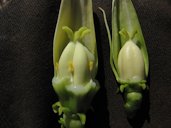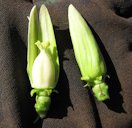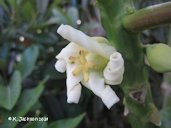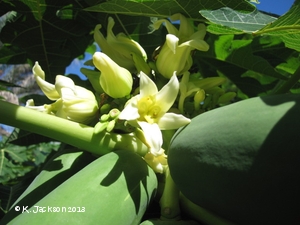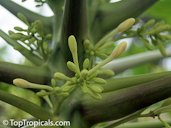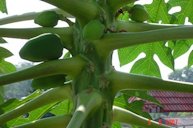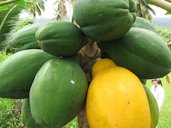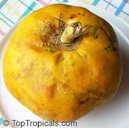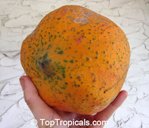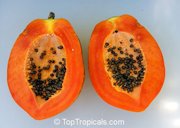Papaya Images Excerpts from Julia Morton's Book Fruits of Warm Climates The bi-sexual plant is self-pollinating. The female plant needs either a male plant or bi-sexual plant nearby for pollination. The female flower is much larger than the bi-sexual flower. The size of the ovary in the female flower is much bigger than the ovary, which is located at the bottom of the bi-sexual flower.
The 5-petalled flowers are fleshy, waxy and slightly fragrant. Some plants bear only short-stalked pistillate (female) flowers, waxy and ivory-white; or hermaprodite (perfect) flowers (having female and male organs), ivory-white with bright-yellow anthers and borne on short stalks; while others may bear only staminate (male) flowers, clustered on panicles to 5 or 6 ft (1.5-1.8 m) long. There may even be monoecious plants having both male and female flowers. Some plants at certain seasons produce short-stalked male flowers, at other times perfect flowers. This change of sex may occur temporarily during high temperatures in midsummer. Some "all-male" plants occasionally bear, at the tip of the spray, small flowers with perfect pistils and these produce abnormally slender fruits. Male or hermaphrodite plants may change completely to female plants after being beheaded.
Fruits from bisexual plants are usually cylindrical or pyriform with small seed cavity and thick wall of firm flesh which stands handling and shipping well. In contrast, fruits from female flowers are nearly round or oval and thin-walled. In some areas, bisexual types are in greatest demand. In South Africa, round or oval papayas are preferred.
Back to Papaya Page |
||||||||||||||||||||||||||||||||||
| Bibliography Fruits of Warm Climates. Julia F. Morton, Miami, 1987. Photographs Fig. 1,2,4 Starr, Forest and Kim. "Carica papaya. Female flower on right hemaphrodite flower on left and Carica papaya Female Flower." Starr Environmental, Hawea Pl Olinda, Maui, 2012, (CC BY 4.0), starrenvironmental.com. Accessed 1 Apr. 2014. Fig. 3 Wright, Jason. Carica papaya." Top Tropicals, toptropicals.com. Accessed 1 Apr. 2014. Fig. 5,7 Jackson, Karen. "Hawai'i Papaya Series.” 2013, www.growables.org. Fig. 8 Starr, Forest and Kim. "Carica papaya Male Flowers." Starr Environmental, Kahanu Gardens Hana, Maui, 2012, (CC BY 4.0), starrenvironmental.com. Accessed 2 Apr. 2014. Fig. 10 Starr, Forest and Kim. "Carica papaya Leaf." Starr Environmental, Sacred Garden of Maliko, Maui, 2011, (CC BY 4.0), starrenvironmental.com. Accessed 1 Apr. 2014. Fig. 11,12 Kwan. "Papaya carica, Papaya." The Plant Observatory, 2007, natureloveyou.sg. Accessed 20 Oct. 2013. Fig. 13,14 Starr, Forest and Kim. "Carica papaya Fruit." Starr Environmental, Kahanu Gardens NTBG Kaeleku Hana, Maui, 2009, (CC BY 4.0), starrenvironmental.com. Accessed 1 Apr. 2014. Fig. 9,15,16,17 "Carica papaya." Top Tropicals, toptropicals.com. Accessed 1 Apr. 2014. Published 20 Mar. 2014 LR. Last update 25 Sept. 2020 LR |
||||||||||||||||||||||||||||||||||

